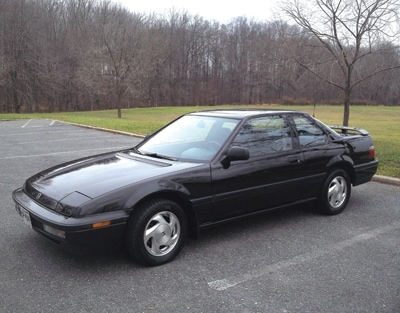
I don’t adapt readily to change. My car is an example of that. I’ve been driving my black Honda Prelude for more than two decades now—and it’s still going strong. Bought new in 1991, it has moved with my family and me from North Carolina to Maryland to Michigan to Idaho and back to Maryland. It has safely transported me on countless trips both near and far. Despite the mileage being just shy of 200,000, its reliability hasn’t wavered, but it’s definitely showing signs of age. My younger brother, who at one time used to plead relentlessly to take my car for a spin, now implores me to purchase another vehicle that’s at least new enough to boast electric locks. I’ve yet to relent.
A few months back, however, I flippantly remarked to my husband that the “old girl” could use a face-lift. Numerous scratches here, a few rust spots there, and a dent in the front driver side were reminding me that my Honda is no longer young. So last Christmas he surprised me with a wonderful gift. No, not a new car—but one that looked almost new. He’d had my Honda meticulously detailed and some paint restoration work done. Together with a high-gloss polish, top-of-the-line replacement wiper blades, and a newly cleaned engine, my car looked little different from when I first drove it off the car lot. I was delighted!
For those of us who grip what’s familiar with both hands (as I have done with my car), adapting to a rapidly changing world is sometimes painful—but change we must, inside the church, as well. God expects us to meet people where they are, and without compromising our biblical beliefs “one jot or tittle,” we’re called to be innovative and think outside the box. This doesn’t mean, however, that we discard everything traditional. If we pause to examine our church carefully, I believe we can see much creative thinking that’s utilizing both fresh and proven methods to propel the gospel forward.
The Adventist Church, for example, has been a leader in harnessing satellite technology to reach more people at one time than ever before. Available today in a variety of viewing platforms, the church’s TV ministry, Hope Channel, touches millions of viewers in Africa, Asia, Europe, South America, and the islands of the Pacific in their own native languages. Such technology boggles the mind!
Satellite broadcasts, however, are not easily accessible in all world regions, but in many of those areas “old-fashioned” shortwave is. Ad-ventist World Radio estimates that its shortwave and AM/FM broadcasts in 80 languages reach a potential two thirds of the world’s population. Last November it began broadcasting for the first time on FM radio in India in the Teluga language. Additional broadcasts in Hindi and English will soon follow.
We also can’t forget the printed page. The Great Hope presidential initiative of giving out massive quantities of Ellen G. White’s book The Great Controversy has to date resulted in millions of copies of the book distributed within our 13 world divisions. Numerous accounts of men and women accepting Jesus as their Savior as a direct result of reading The Great Controversy are reported almost daily.
Just recently I was introduced to the quip “That is so four seconds ago!”—created by a young person, no doubt. This certainly encapsulates the fast-paced world in which we live and the need for the church to keep up. But let’s not totally discard the “tried and true” methods, either. If we polish them a little and fix a scratch or two, we may be surprised at how effective they still can be.
After all, if we reduce evangelism to its basic form, it’s simply one person telling another person about Jesus. By God’s grace we can all do that—no matter which method we use. n